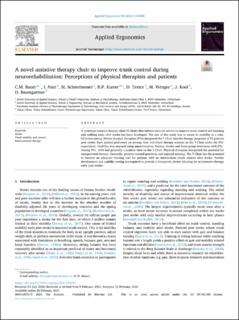Please use this identifier to cite or link to this item:
https://doi.org/10.21256/zhaw-22228Full metadata record
| DC Field | Value | Language |
|---|---|---|
| dc.contributor.author | Bauer, C.M. | - |
| dc.contributor.author | Nast, I. | - |
| dc.contributor.author | Scheermesser, M. | - |
| dc.contributor.author | Kuster, R.P. | - |
| dc.contributor.author | Textor, D. | - |
| dc.contributor.author | Wenger, M. | - |
| dc.contributor.author | Kool, J. | - |
| dc.contributor.author | Baumgartner, D. | - |
| dc.date.accessioned | 2021-04-01T12:50:42Z | - |
| dc.date.available | 2021-04-01T12:50:42Z | - |
| dc.date.issued | 2021 | - |
| dc.identifier.issn | 0003-6870 | de_CH |
| dc.identifier.issn | 1872-9126 | de_CH |
| dc.identifier.uri | https://digitalcollection.zhaw.ch/handle/11475/22228 | - |
| dc.description.abstract | A prototype assistive therapy chair (T-Chair) that induces exercise stimuli to improve trunk control and standing and walking early after stroke has been developed. The aim of this study was to assess its usability in a rehabilitation setting. Eleven physical therapists (PTs) integrated the T-Chair into the therapy programs of 15 patients post stroke. Each patient performed on average four individual therapy sessions on the T-Chair under the PTs' supervision. Usability was assessed using questionnaires, therapy diaries and focus group interviews with PTs'. Among PTs’, 64% had generally a positive view on the T-Chair. Physical therapists recognized the potential for unsupervised therapy. Generally, patients reacted positively and enjoyed training. The T-Chair has the potential to become an adequate training tool for patients with an intermediate trunk control after stroke. Further development and usability testing are required to provide a therapeutic device allowing for an intensive therapy early post stroke. | de_CH |
| dc.language.iso | en | de_CH |
| dc.publisher | Elsevier | de_CH |
| dc.relation.ispartof | Applied Ergonomics | de_CH |
| dc.rights | http://creativecommons.org/licenses/by-nc-nd/4.0/ | de_CH |
| dc.subject | Stroke | de_CH |
| dc.subject | Trunk stability and control | de_CH |
| dc.subject | Robot-assisted therapy | de_CH |
| dc.subject.ddc | 615.82: Physiotherapie | de_CH |
| dc.subject.ddc | 616.8: Neurologie und Krankheiten des Nervensystems | de_CH |
| dc.title | A novel assistive therapy chair to improve trunk control during neurorehabilitation : perceptions of physical therapists and patients | de_CH |
| dc.type | Beitrag in wissenschaftlicher Zeitschrift | de_CH |
| dcterms.type | Text | de_CH |
| zhaw.departement | Gesundheit | de_CH |
| zhaw.departement | School of Engineering | de_CH |
| zhaw.organisationalunit | Institut für Mechanische Systeme (IMES) | de_CH |
| zhaw.organisationalunit | Institut für Physiotherapie (IPT) | de_CH |
| dc.identifier.doi | 10.1016/j.apergo.2021.103390 | de_CH |
| dc.identifier.doi | 10.21256/zhaw-22228 | - |
| zhaw.funding.eu | No | de_CH |
| zhaw.issue | 103390 | de_CH |
| zhaw.originated.zhaw | Yes | de_CH |
| zhaw.publication.status | publishedVersion | de_CH |
| zhaw.volume | 94 | de_CH |
| zhaw.publication.review | Peer review (Publikation) | de_CH |
| zhaw.funding.zhaw | T-CHAIR | de_CH |
| zhaw.author.additional | No | de_CH |
| zhaw.display.portrait | Yes | de_CH |
| Appears in collections: | Publikationen Gesundheit | |
Files in This Item:
| File | Description | Size | Format | |
|---|---|---|---|---|
| 2021_Bauer-etal_T-Chair-neurorehabilitation-perceptions.pdf | 3.7 MB | Adobe PDF |  View/Open |
Show simple item record
Bauer, C. M., Nast, I., Scheermesser, M., Kuster, R. P., Textor, D., Wenger, M., Kool, J., & Baumgartner, D. (2021). A novel assistive therapy chair to improve trunk control during neurorehabilitation : perceptions of physical therapists and patients. Applied Ergonomics, 94(103390). https://doi.org/10.1016/j.apergo.2021.103390
Bauer, C.M. et al. (2021) ‘A novel assistive therapy chair to improve trunk control during neurorehabilitation : perceptions of physical therapists and patients’, Applied Ergonomics, 94(103390). Available at: https://doi.org/10.1016/j.apergo.2021.103390.
C. M. Bauer et al., “A novel assistive therapy chair to improve trunk control during neurorehabilitation : perceptions of physical therapists and patients,” Applied Ergonomics, vol. 94, no. 103390, 2021, doi: 10.1016/j.apergo.2021.103390.
BAUER, C.M., I. NAST, M. SCHEERMESSER, R.P. KUSTER, D. TEXTOR, M. WENGER, J. KOOL und D. BAUMGARTNER, 2021. A novel assistive therapy chair to improve trunk control during neurorehabilitation : perceptions of physical therapists and patients. Applied Ergonomics. 2021. Bd. 94, Nr. 103390. DOI 10.1016/j.apergo.2021.103390
Bauer, C.M., I. Nast, M. Scheermesser, R.P. Kuster, D. Textor, M. Wenger, J. Kool, and D. Baumgartner. 2021. “A Novel Assistive Therapy Chair to Improve Trunk Control during Neurorehabilitation : Perceptions of Physical Therapists and Patients.” Applied Ergonomics 94 (103390). https://doi.org/10.1016/j.apergo.2021.103390.
Bauer, C. M., et al. “A Novel Assistive Therapy Chair to Improve Trunk Control during Neurorehabilitation : Perceptions of Physical Therapists and Patients.” Applied Ergonomics, vol. 94, no. 103390, 2021, https://doi.org/10.1016/j.apergo.2021.103390.
Items in DSpace are protected by copyright, with all rights reserved, unless otherwise indicated.